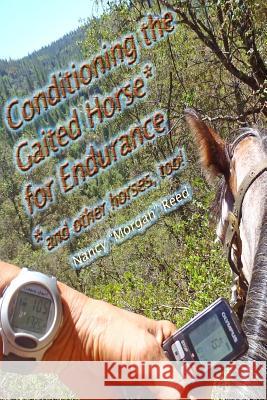Conditioning the Gaited Horse for Endurance » książka
Conditioning the Gaited Horse for Endurance
ISBN-13: 9781516816262 / Angielski / Miękka / 2015 / 70 str.
Gaited horses are gaining in popularity in the sport of endurance. But what is the difference between these breeds and the other more popular breed? Do we have to do something different in order to compete with them? Who better to tackle this question than life-long rider-trainer of Tennessee Walking Horses, M. Reed. Improving condition comes with interval training, a technique illustrated in detail with numerous graphs, showing heart rate recordings from the workouts of 4 horses during interval training in the heat. One 26 mile workout is shown, then the before and after graphs of this horse are compared, showing scientifically, that this method works to lower working heart rate and get faster recoveries. All this can be done with a few simple tools and the workbook graph pages provided to print out. Morgan has had horses most of her life. At age 5, she moved with her family to an 800 acre cattle ranch in the foothills of the Sierra Nevada mountains. There she rode and trained horses as her passion. Now years later, she trains horses and rides in endurance competition. Her horses are bred and trained by herself, and are almost exclusively Tennessee Walking Horses. A few years ago cancer threatened her life. But now on the mend she is riding and training again, and preparing to enter competition again and perhaps tackle the Tevis Cup once again soon. This work book for training the gaited horse for endurance is a natural for her. This is how she got, with very little means, a big Tennessee Walking horse mare to a handful of 50 mile endurance rides and the 100 mile Tevis cup on a shoe string budget. It can be done, although it wasn't easy. She wrote this book to help others be successful with their gaited horses, too. To pass on her experience even though she might not be able to compete again herself. There have been some heated discussions on Social Media regarding my work, and I must commend endurance riders on being very passionate about being endurance riders. I think its one of the most passionate groups of people dedicated to their sport. This book is a novel approach, one never addressed before by other riders or authors. And the responses on social media have been invaluable to me in understanding where people are coming from with regard to their endurance horses and the preparation of them for competition. Some have said that I ask for too much time in the training, too many years in the preparation. And for some, if this is the case, and your horse is ready sooner, fantastic. But as an author, I have to be cautious in asking anyone to put their trusty steed in harms way. Interval training, galloping hills, and endurance riding are "harms way." It is a very rugged sport. What are we asking of our mounts? One poster said "It's BS." Another, "If he cant do it, get rid of him." My first word will always be of caution. Take a little longer, wait a little longer for "repair" and "rest," so your horse will last longer through the years. Most of us don't wish to have to go out and buy another horse. But maybe mine were more difficult than other horses to get ready. I did not choose them for endurance but rather bred, raised them myself for pleasure riding, and perhaps they were not as suited as some horses you might choose as adult horses. Most of us that have gaiteds dont have the luxury of going out and buying one especially for endurance. Besides, who are you going to learn more from, someone with easy to get ready horses or more difficult horses. And gaited horses can be as good or even better athletes if given the time and the rider is willing to do the work. We need to work together with our difficulties and work them out as the everyday endurance rider with our own everyday gaited horses we have at home and love. That's where I'm aiming. I want you all to be winners. To finish is to WIN.
Zawartość książki może nie spełniać oczekiwań – reklamacje nie obejmują treści, która mogła nie być redakcyjnie ani merytorycznie opracowana.











